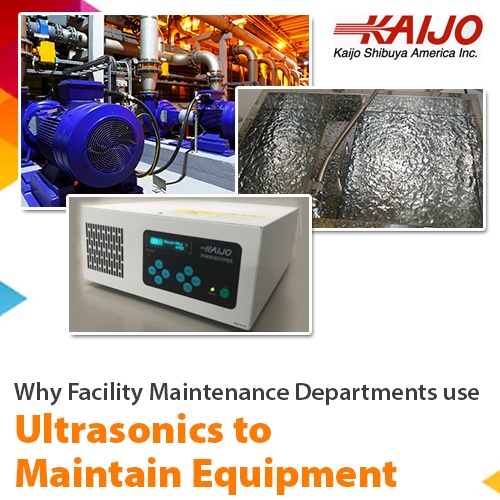Why Facility Maintenance Departments Use Ultrasonics to Maintain Equipment
September 22, 2022
 One thing industrial and commercial operations such as manufacturing, warehouse, research, and service facilities have in common is that they need to maintain equipment. Depending on the manufacturing process, there can be machines for casting, cutting, and stamping that need to be cleaned. Contaminants have to be removed from process tanks and storage containers. Valves may stick, bearings can be full of old grease, and engine parts can have carbon deposits. With all these cases, equipment and parts need maintenance and cleaning.
One thing industrial and commercial operations such as manufacturing, warehouse, research, and service facilities have in common is that they need to maintain equipment. Depending on the manufacturing process, there can be machines for casting, cutting, and stamping that need to be cleaned. Contaminants have to be removed from process tanks and storage containers. Valves may stick, bearings can be full of old grease, and engine parts can have carbon deposits. With all these cases, equipment and parts need maintenance and cleaning.
Warehouses have equipment such as forklifts, cranes, and conveyors with components that may need to be cleaned. Research facilities have sensors and electronic measuring devices that get contaminated. Service facilities have compressors, lifts, and tools. Facility maintenance departments have to be specialized in the corresponding area, but they all need to clean the dirty machine parts and devices. Ultrasonics is the technology that cuts across all these applications. You can clean just about anything with industrial ultrasonic cleaners. An experienced manufacturer can help select the right ultrasonic cleaning system, and the facility maintenance department will use it to deliver improved maintenance at a reduced cost.
How Ultrasonic Cleaners Clean Many Different Types of Equipment
Ultrasonic cleaners generate microscopic cavitation bubbles in the cleaning solution of the cleaning tank. Frequencies as low as 26 kHz and 38 kHz deliver robust cleaning of hard metal parts with comparatively large cavitation bubbles that produce a powerful scrubbing action. Higher frequencies generate smaller bubbles and produce gentler cleaning for parts with soft surfaces, delicate coatings, and fragile structures. The cleaning solution can be plain water, or a mild cleaning solution can be added. The cleaning tank can operate at ambient temperature or be heated. Depending on the parts being cleaned, the ultrasonic cleaning system can be configured to deliver top performance for one type of part or clean various parts with some minor adjustments.
For example, an operator can place small metal parts in a basket and submerge them in a low-frequency ultrasonic parts cleaner tank. Using a heated tank, large metal parts can also be cleaned using low-frequency cleaners to remove hardened greasy deposits. Oily deposits are easily removed by adding a mild solvent to the cleaning solution. Specific solvents that dissolve the contaminant can be used for hard-to-remove films.
Fragile equipment such as optical sensors or pressure switches requires higher-frequency ultrasonic parts cleaners, or their surfaces may be damaged from pitting. Parts plated with a soft metal or parts with a delicate coating may need even higher frequencies, or the cleaning action can damage the surfaces. In each case, the ultrasonic cleaner characteristics have to match the specific cleaning application. Ultrasonic cleaners can be designed to satisfy a variety of cleaning requirements.
Using Industrial Ultrasonic Cleaners for Maintenance Delivers Substantial Advantages
When your industrial ultrasonic cleaners are configured for your maintenance applications and have the required features, improved cleaning performance impacts the quality of equipment maintenance to deliver the following advantages:
- Ultrasonic cleaners are easy to use. Operators place the parts in the cleaning tank, set a timer, and come back to remove the clean parts.
- Ultrasonics delivers fast cleaning with reduced costs for labor.
- No special training is required. Ultrasonic cleaner operation is entirely safe.
- Even intricate parts with complex shapes are cleaned thoroughly, resulting in better maintenance and longer equipment life.
- Because ultrasonics doesn’t use expensive chemicals, cleaning costs are lower.
- Ultrasonics increases workplace safety because there is no need for scraping and hand-brushing parts to remove stubborn deposits.
In-house experts at Kaijo can advise customers and help them select an ultrasonic cleaning system for their specific cleaning application. Kaijo has expertise and experience from working with customers in many different industries. Contact Kaijo for a free consultation to discuss your cleaning application to ensure you choose the right ultrasonic system for your requirements.





